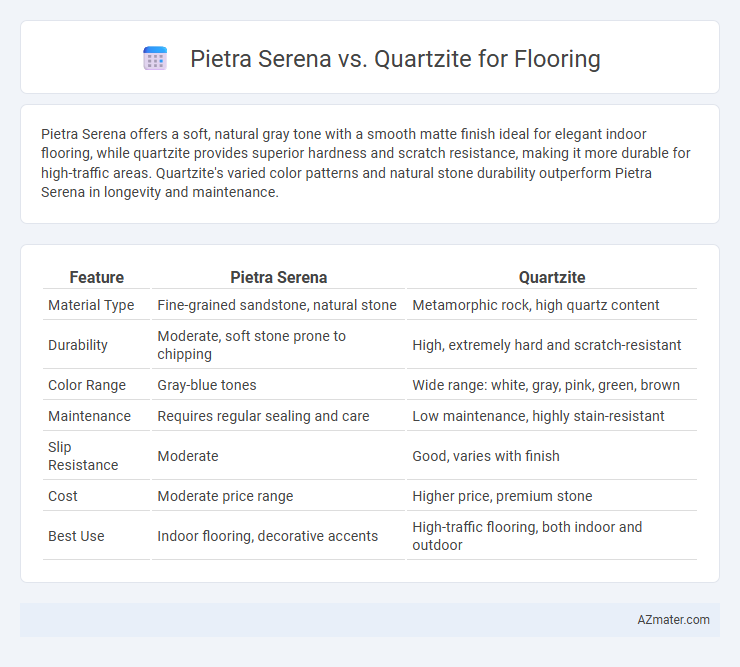Pietra Serena offers a soft, natural gray tone with a smooth matte finish ideal for elegant indoor flooring, while quartzite provides superior hardness and scratch resistance, making it more durable for high-traffic areas. Quartzite's varied color patterns and natural stone durability outperform Pietra Serena in longevity and maintenance.
Table of Comparison
| Feature | Pietra Serena | Quartzite |
|---|---|---|
| Material Type | Fine-grained sandstone, natural stone | Metamorphic rock, high quartz content |
| Durability | Moderate, soft stone prone to chipping | High, extremely hard and scratch-resistant |
| Color Range | Gray-blue tones | Wide range: white, gray, pink, green, brown |
| Maintenance | Requires regular sealing and care | Low maintenance, highly stain-resistant |
| Slip Resistance | Moderate | Good, varies with finish |
| Cost | Moderate price range | Higher price, premium stone |
| Best Use | Indoor flooring, decorative accents | High-traffic flooring, both indoor and outdoor |
Introduction to Pietra Serena and Quartzite
Pietra Serena is a natural Italian sandstone known for its uniform gray-blue color and fine-grained texture, making it a popular choice for elegant and timeless flooring. Quartzite, a metamorphic rock formed from sandstone, features exceptional hardness and durability, often exhibiting varied hues and a shimmering, glassy appearance. Both materials offer unique aesthetic and functional benefits, with Pietra Serena prized for its classic look and Quartzite favored for its strength and resistance to wear.
Origin and Composition of Pietra Serena
Pietra Serena is a fine-grained, blue-gray sandstone primarily quarried in Tuscany, Italy, known for its uniform texture and natural veining, which lends elegance to flooring applications. Its sedimentary origin consists mainly of quartz, feldspar, and clay minerals, contributing to moderate hardness and a matte finish that contrasts with the denser, metamorphic composition of quartzite, which is formed from recrystallized sandstone and contains predominantly quartz crystals. This geological distinction impacts durability and maintenance, with Pietra Serena prized for its aesthetic warmth and historical use in Renaissance architecture.
Geological Formation of Quartzite
Quartzite, a metamorphic rock formed from the recrystallization of quartz sandstone under intense heat and pressure during mountain-building processes, exhibits exceptional hardness and durability ideal for flooring. Pietra Serena, a fine-grained sandstone primarily composed of quartz and feldspar, lacks the extreme metamorphic conditions that create quartzite's dense crystalline structure. The geological formation of quartzite results in a denser, more resistant surface compared to Pietra Serena, making quartzite a superior choice for high-traffic flooring applications.
Aesthetic Differences: Pietra Serena vs Quartzite
Pietra Serena offers a soft, muted grey tone with subtle veining that provides a classic, elegant look ideal for traditional or minimalist interiors, while Quartzite features a more varied color palette, including whites, grays, and golds, with pronounced, dramatic veining that creates a striking, bold appearance. The natural matte finish of Pietra Serena lends a smooth, uniform texture, contrasting with Quartzite's often polished, reflective surface that enhances its vibrant patterns and depth. These aesthetic distinctions make Pietra Serena better suited for understated, timeless flooring designs, whereas Quartzite excels in creating statement floors with high visual impact.
Durability and Hardness Comparison
Pietra Serena, a dense sandstone, offers moderate hardness with a Mohs rating of around 6, making it suitable for low-traffic areas with some susceptibility to scratching and wear. Quartzite, with a Mohs hardness of 7 to 8, provides superior durability and resistance to abrasion, making it ideal for high-traffic flooring applications. The natural strength and resilience of quartzite ensure longer-lasting performance compared to the softer, more porous Pietra Serena.
Maintenance and Upkeep Requirements
Pietra Serena requires regular sealing and gentle cleaning to prevent stains and water damage, making its maintenance moderately demanding compared to quartzite. Quartzite is highly durable and resistant to scratching, heat, and acidic substances, allowing for easier upkeep with less frequent sealing and basic cleaning methods. Both materials benefit from prompt spill cleanup, but quartzite's superior hardness and density make it more suitable for high-traffic flooring with lower long-term maintenance costs.
Cost Differences and Budget Considerations
Pietra Serena offers a more affordable option for flooring compared to Quartzite, with prices typically ranging from $15 to $30 per square foot, making it suitable for budget-conscious projects. Quartzite, known for its durability and aesthetic appeal, generally costs between $45 and $100 per square foot, reflecting its premium quality and longer lifespan. When planning flooring budgets, consider Pietra Serena for cost efficiency and Quartzite for investment in resilience and higher market value.
Suitable Applications for Each Material
Pietra Serena, a dense Italian sandstone known for its smooth texture and elegant gray tones, is ideal for indoor flooring in residential and commercial spaces where aesthetic appeal and moderate durability are required. Quartzite, a natural metamorphic rock with exceptional hardness and resistance to scratches and heat, is suitable for high-traffic areas such as kitchens, hallways, and outdoor patios, offering long-lasting performance and minimal maintenance. When selecting flooring material, consider Pietra Serena for refined, low-traffic environments and quartzite for robust, high-traffic applications demanding superior durability.
Sustainability and Environmental Impact
Pietra Serena, a natural sandstone, offers sustainability through its local sourcing and low-energy extraction processes, reducing its carbon footprint compared to quartzite, which often requires extensive quarrying and transportation. Quartzite is highly durable and resistant to wear, extending the lifespan of flooring and decreasing the need for frequent replacements, indirectly benefiting environmental conservation. Both materials are recyclable and have minimal chemical treatments, but Pietra Serena's softer composition enables easier reclamation and reuse in eco-friendly building designs.
Which is Better for Flooring: Final Verdict
Pietra Serena offers a softer, more elegant appearance ideal for interiors, but Quartzite provides superior hardness and scratch resistance, making it more durable for high-traffic flooring. Quartzite's resistance to staining and weathering makes it better suited for both indoor and outdoor applications, while Pietra Serena requires more maintenance to preserve its natural beauty. For flooring that demands longevity and resilience, Quartzite is the preferred choice.

Infographic: Pietra Serena vs Quartzite for Flooring
 azmater.com
azmater.com